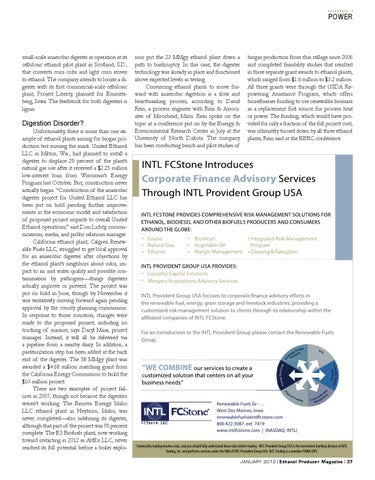POWER
small-scale anaerobic digester in operation at its cellulosic ethanol pilot plant in Scotland, S.D., that converts corn cobs and light corn stover to ethanol. The company intends to locate a digester with its first commercial-scale cellulosic plant, Project Liberty, planned for Emmetsberg, Iowa. The feedstock for both digesters is lignin.
Digestion Disorder?
Unfortunately, there is more than one example of ethanol plants aiming for biogas production but missing the mark. United Ethanol LLC in Milton, Wis., had planned to install a digester to displace 25 percent of the plant’s natural gas use after it received a $2.25 million low-interest loan from Wisconsin’s Energy Program last October. But, construction never actually began. “Construction of the anaerobic digester project for United Ethanol LLC has been put on hold pending further improvements in the economic model and satisfaction of proposed project impacts to overall United Ethanol operations,” said Dori Lichty, communications, media, and public relations manager. California ethanol plant, Calgren Renewable Fuels LLC, struggled to get local approval for an anaerobic digester after objections by the ethanol plant’s neighbors about odor, impact to air and water quality and possible contamination by pathogens—things digesters actually improve or prevent. The project was put on hold in June, though by November it was tentatively moving forward again pending approval by the county planning commission. In response to those concerns, changes were made to the proposed project, including no trucking of manure, says Daryl Maas, project manager. Instead, it will all be delivered via a pipeline from a nearby dairy. In addition, a pasteurization step has been added at the back end of the digester. The 58 MMgy plant was awarded a $4.68 million matching grant from the California Energy Commission to build the $10 million project. There are two examples of project failures in 2007, though not because the digesters weren’t working. The Renova Energy Idaho LLC ethanol plant in Heyburn, Idaho, was never completed—also sidelining its digester, although that part of the project was 95 percent complete. The E3 Biofuels plant, now working toward restarting in 2012 as AltEn LLC, never reached its full potential before a boiler explo-
sion put the 23 MMgy ethanol plant down a path to bankruptcy. In this case, the digester technology was already in place and functioned above expected levels in testing. Convincing ethanol plants to move forward with anaerobic digestion is a slow and heartbreaking process, according to David Rein, a process engineer with Rein & Associates of Moorhead, Minn. Rein spoke on the topic at a conference put on by the Energy & Environmental Research Center in July at the University of North Dakota. The company has been conducting bench and pilot studies of
biogas production from thin stillage since 2006 and completed feasibility studies that resulted in three separate grant awards to ethanol plants, which ranged from $1.6 million to $3.2 million. All three grants were through the USDA Repowering Assistance Program, which offers biorefineries funding to use renewable biomass as a replacement fuel source for process heat or power. The funding, which would have provided for only a fraction of the full project cost, was ultimately turned down by all three ethanol plants, Rein said at the EERC conference.
january 2012 | Ethanol Producer Magazine | 37
